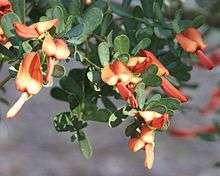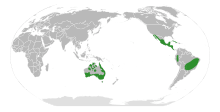Brongniartieae
| Brongniartieae | |
|---|---|
 | |
| Templetonia retusa | |
| Scientific classification | |
| Kingdom: | Plantae |
| (unranked): | Angiosperms |
| (unranked): | Eudicots |
| (unranked): | Rosids |
| Order: | Fabales |
| Family: | Fabaceae |
| Subfamily: | Faboideae |
| (unranked): | Genistoids |
| Tribe: | Brongniartieae (Benth.) Ross and Crisp[1][2] |
| Genera[3][4] | |
| |
 | |
| Range of the Brongniartieae | |
| Synonyms[5] | |
| |
The tribe Brongniartieae is one of the subdivisions of the plant family Fabaceae, primarily found in tropical regions of the Americas and in Australia[6] The members of this tribe consistently form a monophyletic clade in molecular phylogenetic analyses.[4][7][8][9][10][11][12][13][14][15] The tribe does not currently have a node-based definition, but morphological synapomorphies have been identified:
"stamens united by filaments in an adaxially open tube; anthers alternately long and basifixed, short and versatile; anther connective inconspicuous; septa present between seeds in pods; aril lateral lobe present and fitting into heel of funicle; fine red glandular processes present in axils; and pollen tricolporate with opercula and no definite endoaperture."[4][6][16]
Notes
References
- ↑ Ross JH, Crisp MD (2005). "Brongniartieae". In Lewis G, Schrire B, Mackinder B, Lock M. Legumes of the World. Royal Botanic Gardens, Kew. pp. 253–259. ISBN 1900347806.
- ↑ Wojciechowski MF. (2013). "Towards a new classification of Leguminosae: Naming clades using non-Linnaean phylogenetic nomenclature". S Afr J Bot. 89: 85–93. doi:10.1016/j.sajb.2013.06.017.
- ↑ de Queiroz LP, Lewis GP, Wojciechowski MF (2010). "Tabaroa, a new genus of Leguminosae tribe Brongniartieae from Brazil". Kew Bull. 65 (2): 189–203. doi:10.1007/s12225-010-9202-7. JSTOR 23216080.
- 1 2 3 Cardoso D, Pennington RT, de Queiroz LP, Boatwright JS, Van Wyk BE, Wojciechowski MF, Lavin M (2013). "Reconstructing the deep-branching relationships of the papilionoid legumes". S Afr J Bot. 89: 58–75. doi:10.1016/j.sajb.2013.05.001.
- ↑ Ross JH, Crisp MD (23 July 2013). "Kew Royal Botanic Gardens entry for Brongniartieae". Kew. Royal Botanic Gardens, Kew. Retrieved 17 February 2014.
- 1 2 Thompson IR, Ladiges PY, Ross JH (2001). "Phylogenetic studies of the tribe Brongniartieae (Fabaceae) using nuclear DNA (ITS-1) and morphological data". Syst Bot. 26 (3): 557–570. doi:10.1043/0363-6445-26.3.557. JSTOR 3093981.
- ↑ Hu JM, Lavin M, Wojciechowski MF, Sanderson MJ (2002). "Phylogenetic analysis of nuclear ribosomal ITS/5.85 sequences in the tribe Millettieae (Fabaceae): Poecilanthe–Cyclolobium, the core Millettieae, and the Callerya group". Syst Bot. 27 (4): 722–733. doi:10.1043/0363-6445-27.4.722.
- ↑ Cardoso D, de Queiroz LP, Pennington RT, de Lima HC, Fonty É, Wojciechowski MF, Lavin M (2012). "Revisiting the phylogeny of papilionoid legumes: new insights from comprehensively sampled early-branching lineages". Am J Bot. 99 (12): 1991–2013. doi:10.3732/ajb.1200380.
- ↑ Wojciechowski MF, Lavin M, Sanderson MJ (2004). "A phylogeny of legumes (Leguminosae) based on analysis of the plastid matK gene resolves many well-supported subclades within the family". Am J Bot. 91 (11): 1846–1862. doi:10.3732/ajb.91.11.1846. PMID 21652332.
- ↑ Wink M, Mohamed GI (2003). "Evolution of chemical defense traits in the Leguminosae: mapping of distribution patterns of secondary metabolites on a molecular phylogeny inferred from nucleotide sequences of the rbcL gene". Biochem Syst Ecol. 31 (8): 897–917. doi:10.1016/S0305-1978(03)00085-1.
- ↑ Pennington RT, Lavin M, Ireland H, Klitgaard B, Preston J, Hu JM (2001). "Phylogenetic relationships of basal papilionoid legumes based upon sequences of the chloroplast trnL intron". Syst Bot. 55 (5): 818–836. doi:10.1043/0363-6445-26.3.537.
- ↑ Crisp MD, Gilmore S, Van Wyk BE (2000). "Molecular phylogeny of the genistoid tribes of papilionoid legumes". In Herendeen PS, Bruneau A. Advances in Legume Systematics, Part 9. Royal Botanic Gardens, Kew. pp. 249–276. ISBN 184246017X.
- ↑ Doyle JJ, Chappill JA, Bailey CD, Kajita T (2000). "Towards a comprehensive phylogeny of legumes: evidence from rbcL sequences and non-molecular data". In Herendeen PS, Bruneau A. Advances in Legume Systematics, Part 9. Royal Botanic Gardens, Kew. pp. 1–20. ISBN 184246017X.
- ↑ Lavin M, Herendeen PS, Wojciechowski MF (2005). "Evolutionary rates analysis of Leguminosae implicates a rapid diversification of lineages during the tertiary". Syst Biol. 54 (4): 575–94. doi:10.1080/10635150590947131. PMID 16085576.
- ↑ LPWG [Legume Phylogeny Working Group] (2013). "Legume phylogeny and classification in the 21st century: progress, prospects and lessons for other species-rich clades". Taxon. 62 (2): 217–248. doi:10.12705/622.8.
- ↑ Crisp MD, Weston PH (1987). "Cladistics and legume systematics, with an analysis of the Bossiaeeae, Brongniartieae and Mirbelieae". In Stirton CH. Advances in Legume Systematics, Part 3. Royal Botanic Gardens, Kew. pp. 65–130. ISBN 0947643079.
External links
 Media related to Brongniartieae at Wikimedia Commons
Media related to Brongniartieae at Wikimedia Commons Data related to Brongniartieae at Wikispecies
Data related to Brongniartieae at Wikispecies
This article is issued from Wikipedia - version of the 9/10/2016. The text is available under the Creative Commons Attribution/Share Alike but additional terms may apply for the media files.